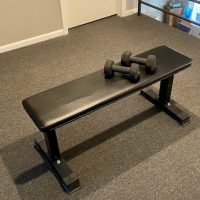 A couple of years ago I added some resistance training to my workout (30 minutes a day on the treadmill). Started with little (5 pound) barbells working mostly on my upper body. Just trying to keep some muscle tone as I age. After a while I moved up to 10 pound weights and that seems about right. I had no idea if the weights were doing me any good but a piece in The Washington Post argues that cardio isn’t enough, you need resistance training, too.
A couple of years ago I added some resistance training to my workout (30 minutes a day on the treadmill). Started with little (5 pound) barbells working mostly on my upper body. Just trying to keep some muscle tone as I age. After a while I moved up to 10 pound weights and that seems about right. I had no idea if the weights were doing me any good but a piece in The Washington Post argues that cardio isn’t enough, you need resistance training, too.
The piece sites a couple of studies including research that shows weight training reduces your risk of diabetes, stroke ad heart disease. Similarly, “a 2019 study, which included nearly 13,000 people, performing resistance training for less than an hour per week was associated with roughly 40 to 70 percent decreased risk of cardiovascular disease and all-cause mortality — independent of any aerobic exercise.” The article explains how resistance training yields these benefits.
So I’ll keep my little weight bench and my baby barbells and keep pumping till I can’t pump no more.
